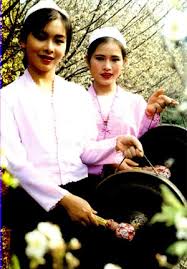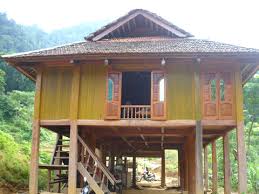With boisterous Gong music, salty flavour of "Ruou can", the Muong ethnic group remain preserve the national culture and bring into play the nation's traditions for successive generations.
 Name of ethnic group: Muong (Moi, Mual, Moi, Moi Bi, Au Ta and Ao Ta)
Name of ethnic group: Muong (Moi, Mual, Moi, Moi Bi, Au Ta and Ao Ta)
Population: More than 1,137,515 people (Year 1999)
Locality: The largest population is concentrated in Hoa Binh Province and the mountainous districts of Thanh Hoa Province.
Customs and habits: In former days, the "lang dao" system characterized Muong society. The "lang dao" ruled the Muong regions. A head of a "muong" was a "lang cun", "lang xom", or "dao xom".
Muong marriage customs are similar to the Kinh. When a woman is giving birth to a child, her family surrounds the main ladder to the house with a bamboo fence. The child will be given a name when it is one year old. The Muong hold funerals with strict rules. Muong practice a polytheistic religion and ancestor worship.
Culture: The Muong language belongs to the Viet-Muong group. The popular literature and arts of the Muong are rich and include long poems, "mo" (ceremonial songs), folksongs, dialogue duets, proverbs, lullabies, and children's songs. The gong is a favorite musical instrument of the Muong, as are the two stringed violins, flutes, drums and pan pipes.
The Muong hold many ceremonies year round such as the Going to the Fields Ceremony ("Khuong Mua"), Praying-for-Rain Ceremony (during the fourth lunar month), Washing Rice Leaves Ceremony (during the seventh and eighth lunar months), and the New Rice Ritual.

Costumes: Men dress in indigo pajamas. Women wear white rectangular scarves, bras, long skirts, and short vests that are open at the front (or at the shoulders) without buttons. The skirt is complemented by a very large silk belt embroidered with various motifs such as flowers, figures, dragons, phoenixes, deer, and birds.
Economy: The Muong have practiced farming for a long time. Wet rice is their main food staple. Other family income is generated through the exploitation of forest products including mushrooms, dried fungus, ammonium, and sticklac. Muong handicrafts include weaving, basketry, and silk spinning. Muong women are known to be very skilled at loom weaving.

 bởi
bởi 
